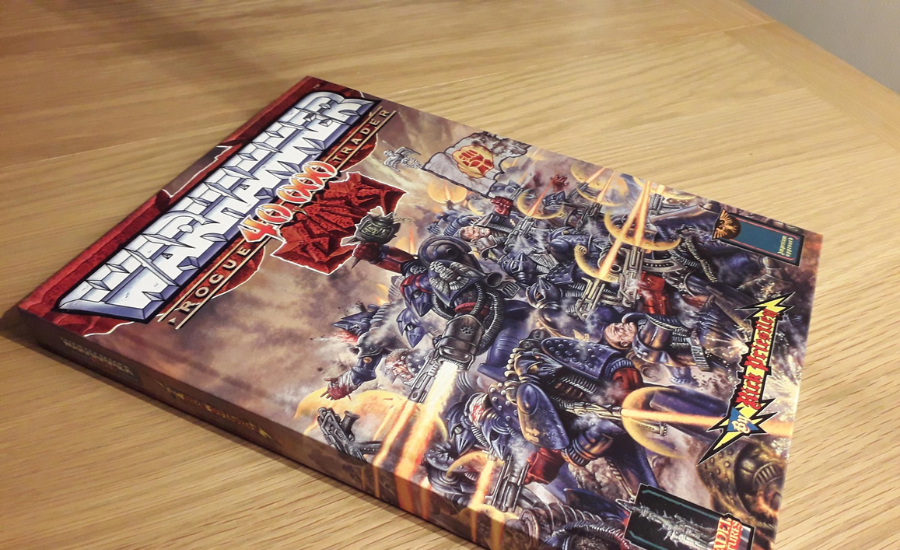The Gang Busters Rule in Warhammer 8th Edition 40k is a vital and ever-changing aspect of the game, reflecting the complexity of this competitive environment. Each new edition brings fresh rules, strategies, and shifts in the meta that can dramatically alter how players engage with the game. The 8th Edition of Warhammer 40k was no different, introducing numerous updates and additions that kept players adapting their strategies. One notable feature from this edition is the The Gang Busters Rule in Warhammer 8th Edition , which emerged as a significant tactical consideration that could heavily influence the outcome of battles.
In the 8th Edition of Warhammer 40k, the Gang Busters Rule in Warhammer 8th Edition was introduced as a secondary objective in competitive play, aimed at addressing the challenge posed by multi-wound infantry units. These units, known for their resilience and difficulty to eliminate, often proved to be a formidable obstacle on the battlefield. The Gang Busters Rule in Warhammer 8th Edition was specifically designed to counteract this by providing players with incentives for effectively dismantling these durable units.
The core of the Gang Busters Rule in Warhammer 8th Edition revolves around rewarding players for damaging enemy units composed of multi-wound models. This rule introduces an additional layer of strategic depth, compelling players to carefully consider their choices regarding target prioritisation and how they allocate their resources during the game.
Strategic Significance of Multi-Wound Units in Warhammer 40k 8th Edition
Multi-wound units have always been pivotal in Warhammer 40k, serving as a crucial element in balancing the resilience of vehicles with the numbers of standard infantry. These units, often classified as “elite infantry,” include iconic models such as Space Marine Terminators, Tyranid Warriors, and Crisis Battlesuits. The multi-wound feature of these models allows them to withstand significantly more damage compared to standard infantry, making them valuable assets on the battlefield. Their ability to absorb multiple hits before being taken out of play provides a tactical advantage, enabling them to hold key positions or execute crucial missions where standard infantry might falter.
However, the introduction of the Gang Busters Rule in the 8th Edition in Warhammer 8th Edition brought a new challenge to the deployment of multi-wound units. This rule, designed to counteract the dominance of these durable models, allowed opponents to earn secondary objective points by targeting and reducing multi-wound units. This change forced players to re-evaluate the role and strategic deployment of elite infantry within their armies. Where these units were once considered almost invulnerable linchpins in a battle plan, they now had to be used with greater caution.
Players had to develop new tactics to protect their multi-wound units from becoming easy targets. This often involved more thoughtful positioning on the battlefield, utilising cover effectively, and ensuring these units were supported by other elements of the army to mitigate the risk of concentrated enemy fire. The Gang Busters Rule introduced a layer of strategic depth to the game, as it required players to weigh the potential risks and rewards of deploying multi-wound units in various scenarios. In doing so, it reshaped the meta of competitive play, emphasising the importance of adaptability and strategic foresight in Warhammer 40k.
Strategies for Maximising Gang Busters Points
To maximise your points with the Gang Busters Rule, it’s essential to employ strategies that align with your army’s strengths while exploiting the vulnerabilities of your opponent. Here are key tactics to help you optimise your approach:
- Target Prioritization: Maximising Gang Busters points hinges on effective target selection. Focus your efforts on elite infantry units that are crucial to your opponent’s battle plan. These multi-wound units are prime candidates for Gang Busters points, especially if they are positioned in areas where they are actively engaged in combat. Prioritising these targets allows you to consistently apply pressure, gradually wearing them down to accumulate points.
- Optimal Weapon Selection: Selecting the appropriate weapons is critical when aiming to maximise your Gang Busters points. Weapons with high rates of fire combined with solid Strength values are particularly effective against multi-wound units. Plasma guns, heavy bolters, and similar armaments are excellent choices as they can inflict steady damage across multiple turns, enhancing your ability to earn points by reducing enemy models.
- Concentrated Firepower: Rather than dispersing your attacks across several units, focusing your firepower on a single multi-wound unit is a more effective tactic. This approach increases the likelihood of eliminating models within that unit, allowing you to accumulate Gang Busters in Warhammer 8th Edition points more efficiently. By concentrating your attacks, you enhance your chances of quickly removing these high-value targets from the battlefield.
4. Patience and Timing
When aiming to maximise your Gang Busters points, patience is crucial. Rather than rushing into engagements, it may be more strategic to wait for the opportune moment to strike. By biding your time, you can catch your opponent off-guard, allowing you to concentrate your forces and deliver a decisive blow in a single turn. This approach prevents the premature expenditure of resources and increases your chances of scoring big.
5. Synergizing with Other Rules
The Gang Busters Rule in Warhammer 8th Edition doesn’t operate in a vacuum—it works in harmony with other objectives and rules within the game. To fully capitalize on this secondary objective, consider how it aligns with your army’s primary goals and overall strategy. For example, combining Gang Busters in Warhammer 8th Edition with objectives that emphasize board control can create powerful synergies, enabling you to maximize your point accumulation while maintaining strategic dominance on the battlefield.
Faction-Specific Tactics: Tailoring the Gang Busters Rule to Your Army
Every faction in Warhammer 40k has distinct advantages and challenges, and adapting the Gang Busters Rule in Warhammer 8th Edition to fit your army’s characteristics is crucial for success. Let’s delve into how different factions can either leverage or counter the Gang Busters Rule effectively.
Astra Militarum (Imperial Guard)
The Astra Militarum excels in sheer numbers and overwhelming firepower. Although this faction doesn’t typically rely on multi-wound infantry, it possesses a significant advantage when it comes to exploiting the Gang Busters Rule. By fielding vast numbers of heavy weapons and utilising target saturation, the Imperial Guard can efficiently dismantle elite enemy units, quickly accumulating Gang Busters points. Their ability to bring an overwhelming volume of fire to bear makes them particularly adept at exploiting this secondary objective.

Space Marines
Space Marines frequently deploy units such as Terminators or Primaris Marines, making them prime targets under the Gang Busters Rule. To minimise the impact of this rule, Space Marine players should emphasize protective strategies. Effective use of cover is essential, as it reduces the damage these units take from enemy fire. Additionally, focusing on eliminating the most threatening enemy units can protect your multi-wound models from becoming easy targets. By leveraging the inherent durability of Space Marine units to secure and hold objectives, players can also counterbalance the potential points their opponents might gain from Gang Busters.
Tyranids
Tyranid armies often rely on multi-wound units like Tyranid Warriors and Hive Guard, which are crucial for providing both firepower and synapse control. To mitigate the risks posed by the Gang Busters Rule, Tyranid players should spread their forces across the battlefield, preventing any single unit from being overexposed to concentrated enemy fire. Maintaining unit diversity and avoiding clumping can limit the effectiveness of your opponent’s attacks. Additionally, the Tyranids’ natural speed and mobility can be used to outmanoeuvre opponents, reducing opportunities for them to score Gang Busters points.
Necrons
Necrons field several multi-wound units, such as Destroyers and Lychguard, which play a central role in their strategic framework. However, Necrons possess a distinctive advantage in the form of Reanimation Protocols, which allow them to revive fallen models. This unique ability can complicate Gang Busters scoring for opponents, as it reduces the effectiveness of their efforts to eliminate Necron units. By skillfully utilising Reanimation Protocols, Necron players can deny their opponents easy points and maintain their forces’ presence on the battlefield.
Advanced Tactics: Mitigating the Impact of the Gang Busters Rule
Although the Gang Busters Rule can be advantageous, it poses a challenge if your strategy depends on multi-wound units. To protect these valuable assets and reduce your opponent’s ability to capitalize on this rule, consider implementing the following tactics:
Deploy Distraction Units
To shield your multi-wound models from becoming easy targets, utilize low-value or single-wound units as distractions. For example, units like Guardsmen or Ork Boyz can serve as sacrificial pawns, drawing enemy fire away from your more critical elite infantry. By absorbing damage that might otherwise be directed at your multi-wound units, these distractions can help preserve your key forces.
Disperse Your Units
One of the most effective ways to counteract the Gang Busters Rule is to avoid clustering your multi-wound units together. When these units are grouped, it becomes easier for your opponent to focus their fire and rack up Gang Busters points. Instead, spread your multi-wound models across the battlefield, forcing the enemy to split their attacks. This strategy dilutes their firepower, making it more difficult for them to concentrate on a single target and reducing the effectiveness of their Gang Busters scoring.
3. Establishing Denial Zones
Creating strategic denial zones on the battlefield can significantly limit your opponent’s ability to target your multi-wound units effectively. Utilize terrain features to shield these units, positioning them in areas where the enemy must take considerable risks to engage.
4. Reducing Visibility and Exposure
Minimising the exposure of your multi-wound units is critical to countering the Gang Busters Rule. Utilise cover and terrain to keep your units out of sight, only moving them into vulnerable positions when absolutely necessary. By carefully managing when and where your units are visible, you can limit the opportunities your opponent has to score Gang Busters points, thereby preserving your key models for more critical phases of the game.
Impact on Competitive Play: The Gang Busters Rule’s Influence on Tournaments
One of the major changes was the move towards more balanced army lists. Previously, players might have leaned heavily on multi-wound units to dominate the battlefield, but the risk of yielding Gang Busters points forced a reconsideration. Army lists became more diverse, incorporating a mix of single-wound and multi-wound models to balance resilience with scoring potential.

Additionally, the Gang Busters Rule added a layer of complexity to competitive matches, encouraging players to engage in more dynamic and thoughtful gameplay. The need to carefully consider unit placement, target priority, and the timing of attacks made for more engaging and unpredictable tournaments, where strategic thinking often determined the outcome. This rule ultimately enriched the competitive environment by promoting a deeper level of tactical decision-making.
Player Reactions: Community Views on the Gang Busters Rule
The Warhammer 40K community had varied responses to the introduction of the Gang Busters Rule. While some players welcomed the additional strategic complexity it introduced, others felt that it disproportionately impacted certain armies, particularly those that depended on multi-wound units.
Supportive Reactions
Advocates of the Gang Busters Rule appreciated its role in balancing the game, especially against armies that relied heavily on elite infantry. They saw the rule as a mechanism that encouraged more varied army compositions, pushing players to diversify their forces and think critically about their deployment strategies. Many found the challenge of adjusting their tactics to this new objective an exciting aspect of the game, as it rewarded players who could skillfully navigate the added layer of strategy.
Critical Reactions
Conversely, some members of the community believed the Gang Busters Rule unfairly penalized certain factions. Armies like the Adeptus Custodes or Death Guard, known for their reliance on tough, multi-wound units, were particularly vulnerable to this rule. Critics argued that the rule forced these factions into less effective strategies or made them easier targets for opponents seeking to score quick points, which could be frustrating in competitive play.
Despite these differing perspectives, the Gang Busters Rule maintained its place in 8th Edition tournaments, significantly influencing the competitive meta.

The Gang Busters Rule, introduced in Warhammer 40K’s 8th Edition, is a prime example of how secondary objectives can significantly influence game dynamics and strategy. This rule offers valuable insights into the development and impact of secondary objectives in competitive play.
1. Promoting Diverse Army Builds
A major takeaway from the Gang Busters Rule is its role in promoting diversity within army compositions. By introducing penalties for relying solely on multi-wound units, the rule encouraged players to create more balanced and versatile lists.
2. Emphasizing Tactical Expertise
The Gang Busters Rule underscored the importance of tactical acumen in gameplay. It rewarded players who skillfully targeted and neutralized multi-wound units, while those who struggled with this objective found themselves at a disadvantage.
3. Balancing Risk and Reward
Lastly, the Gang Busters Rule highlighted the necessity of balancing risk with reward in game design. Although the rule provided a strong incentive to target multi-wound units, it also required players to weigh their actions carefully.
Gang Busters Rule: Anticipating Future Developments
As Warhammer 40K progresses, the insights gained from the Gang Busters Rule will likely influence future editions of the game. The role this rule played in shaping the 8th Edition competitive scene underscores the potential impact secondary objectives can have, suggesting that future iterations may build on these concepts.
1. Evolving Secondary Objectives
Future Warhammer 40K editions might see enhanced and refined secondary objectives inspired by the Gang Busters Rule. Game designers could focus on developing objectives that foster diverse army compositions while continuing to reward strategic prowess.
2. Adapting to Changes in the Meta
As the game’s meta evolves, secondary objectives will need to adapt to address emerging trends. The Gang Busters Rule was tailored to counteract the dominance of multi-wound units; future rules might be designed to address new patterns or challenges that arise within the competitive environment, ensuring that secondary objectives remain relevant and impactful.
3. Ensuring Balanced Faction Play
The influence of the Gang Busters Rule on various factions highlights the importance of balance in future game editions. Designers may need to create objectives that accommodate the unique strengths and limitations of different factions. This could involve developing faction-specific objectives or offering alternative scoring mechanisms that align better with the characteristics of each army.

Facts
- Introduction: The Gang Busters Rule was introduced in Warhammer 40K 8th Edition as a secondary objective.
- Purpose: To counter the dominance of multi-wound infantry units by rewarding players for targeting and damaging them.
- Key Units: Affects multi-wound units like Space Marine Terminators, Tyranid Warriors, and Crisis Battlesuits.
- Gameplay Impact: Encourages strategic focus on multi-wound units, influencing target selection and resource allocation.
- Competitive Scene: Promoted diverse army lists and introduced greater strategic complexity in competitive play.
FAQs
Q: What is the Gang Busters Rule in Warhammer 40K 8th Edition?
The Gang Busters Rule is a secondary objective introduced in the 8th Edition of Warhammer 40K. It is designed to reward players for effectively targeting and damaging enemy units composed of multi-wound models. This rule aims to address the challenge posed by resilient, multi-wound infantry units by providing points for their elimination.
Q: How does the Gang Busters Rule impact gameplay?
A: The Gang Busters Rule adds a layer of strategic depth to gameplay. It encourages players to prioritize and focus their attacks on multi-wound units, influencing decisions on target selection, resource allocation, and battlefield positioning. This rule reshapes strategies and tactics, requiring players to adapt their approaches to maximize their point accumulation.
Q: What types of units benefit from the Gang Busters Rule?
A: Units that benefit from the Gang Busters Rule are those that consist of multi-wound models. These include elite infantry units such as Space Marine Terminators, Tyranid Warriors, and Crisis Battlesuits. These units are often used for their durability and ability to hold key positions on the battlefield.
Q: How can players maximize their points with the Gang Busters Rule?
A: To maximize points, players should focus on prioritizing high-value multi-wound targets, selecting effective weapons with high damage output, and concentrating firepower on individual units to ensure their elimination.
Q: How did the Gang Busters Rule affect the competitive Warhammer 40K scene?
A: The introduction of the Gang Busters Rule led to more balanced army compositions, as players were encouraged to diversify their units to mitigate the rule’s impact.
Conclusion
The Gang Busters Rule has made a significant impact on Warhammer 40K 8th Edition by introducing a new layer of strategic depth. By incentivizing players to target and dismantle multi-wound units, the rule has reshaped how armies are built and how battles are conducted. Its influence is evident in the evolving competitive landscape, encouraging diverse army compositions and strategic adaptability. As Warhammer 40K continues to evolve, the insights gained from the Gang Busters Rule will likely inform future editions, leading to more nuanced and balanced gameplay experiences.
Read more : News Week Blog



